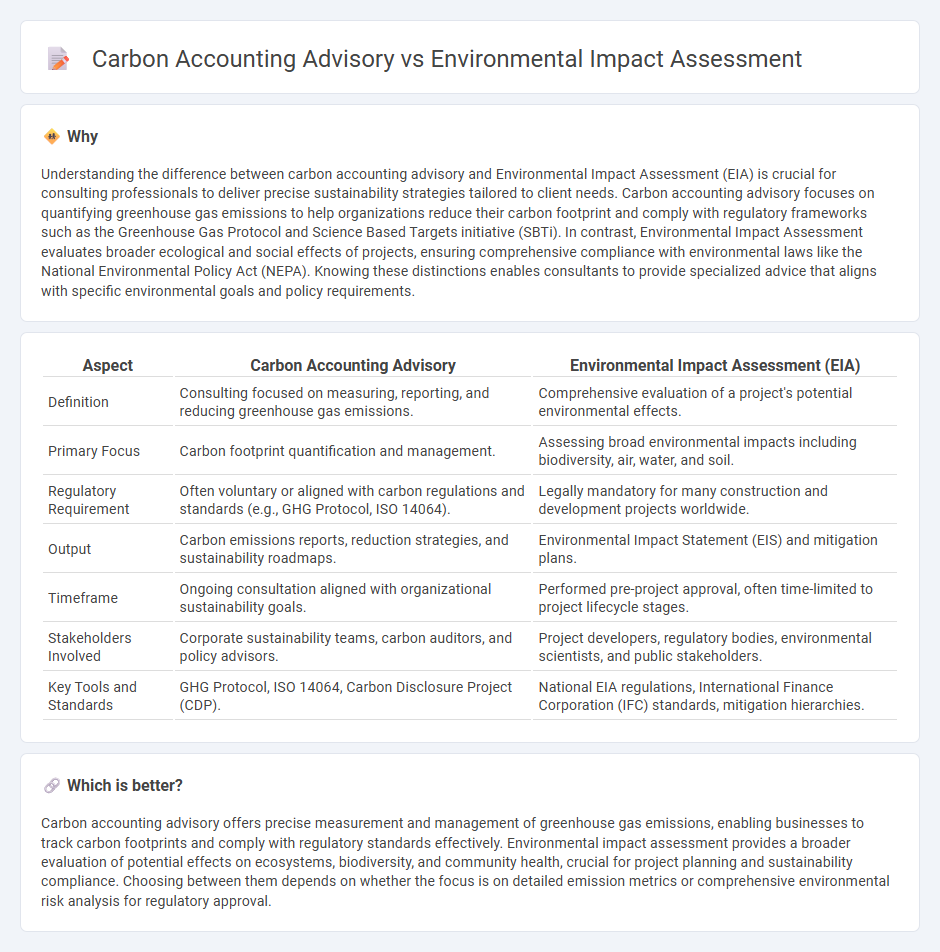
Carbon accounting advisory specializes in quantifying and managing greenhouse gas emissions to help organizations meet regulatory requirements and sustainability goals. Environmental impact assessments evaluate the potential ecological effects of proposed projects, ensuring compliance with environmental laws and minimizing harm to natural resources. Explore detailed insights to understand which service best suits your sustainability objectives.
Why it is important
Understanding the difference between carbon accounting advisory and Environmental Impact Assessment (EIA) is crucial for consulting professionals to deliver precise sustainability strategies tailored to client needs. Carbon accounting advisory focuses on quantifying greenhouse gas emissions to help organizations reduce their carbon footprint and comply with regulatory frameworks such as the Greenhouse Gas Protocol and Science Based Targets initiative (SBTi). In contrast, Environmental Impact Assessment evaluates broader ecological and social effects of projects, ensuring comprehensive compliance with environmental laws like the National Environmental Policy Act (NEPA). Knowing these distinctions enables consultants to provide specialized advice that aligns with specific environmental goals and policy requirements.
Comparison Table
| Aspect | Carbon Accounting Advisory | Environmental Impact Assessment (EIA) |
|---|---|---|
| Definition | Consulting focused on measuring, reporting, and reducing greenhouse gas emissions. | Comprehensive evaluation of a project's potential environmental effects. |
| Primary Focus | Carbon footprint quantification and management. | Assessing broad environmental impacts including biodiversity, air, water, and soil. |
| Regulatory Requirement | Often voluntary or aligned with carbon regulations and standards (e.g., GHG Protocol, ISO 14064). | Legally mandatory for many construction and development projects worldwide. |
| Output | Carbon emissions reports, reduction strategies, and sustainability roadmaps. | Environmental Impact Statement (EIS) and mitigation plans. |
| Timeframe | Ongoing consultation aligned with organizational sustainability goals. | Performed pre-project approval, often time-limited to project lifecycle stages. |
| Stakeholders Involved | Corporate sustainability teams, carbon auditors, and policy advisors. | Project developers, regulatory bodies, environmental scientists, and public stakeholders. |
| Key Tools and Standards | GHG Protocol, ISO 14064, Carbon Disclosure Project (CDP). | National EIA regulations, International Finance Corporation (IFC) standards, mitigation hierarchies. |
Which is better?
Carbon accounting advisory offers precise measurement and management of greenhouse gas emissions, enabling businesses to track carbon footprints and comply with regulatory standards effectively. Environmental impact assessment provides a broader evaluation of potential effects on ecosystems, biodiversity, and community health, crucial for project planning and sustainability compliance. Choosing between them depends on whether the focus is on detailed emission metrics or comprehensive environmental risk analysis for regulatory approval.
Connection
Carbon accounting advisory and environmental impact assessment are interconnected through their shared goal of quantifying and mitigating environmental risks associated with business operations. Carbon accounting advisory provides detailed measurements of greenhouse gas emissions, forming a critical component of environmental impact assessments by offering data-driven insights for regulatory compliance and sustainability strategies. Together, they enable organizations to develop comprehensive environmental management plans that reduce carbon footprints and improve ecological outcomes.
Key Terms
Baseline Assessment
Environmental impact assessment evaluates the overall ecological consequences of projects, while carbon accounting advisory focuses specifically on quantifying greenhouse gas emissions. Baseline assessment in environmental impact identifies existing environmental conditions to measure changes, whereas in carbon accounting, it determines the initial carbon footprint to track emission reductions. Discover how baseline assessments shape effective sustainability strategies.
Emissions Inventory
Emissions Inventory serves as a foundational component in both Environmental Impact Assessment (EIA) and Carbon Accounting Advisory, enabling accurate tracking of greenhouse gas outputs from various industrial activities. While EIA evaluates potential environmental consequences and regulatory compliance, Carbon Accounting Advisory emphasizes quantifying, reporting, and reducing carbon footprints to enhance sustainability efforts. Explore comprehensive strategies for optimizing Emissions Inventory to improve environmental decision-making and corporate carbon management.
Mitigation Strategies
Environmental impact assessment (EIA) evaluates the potential consequences of a project on ecosystems, aiming to identify and mitigate negative effects through comprehensive analysis of air, water, and soil quality changes. Carbon accounting advisory specializes in quantifying greenhouse gas emissions to develop targeted mitigation strategies that reduce an organization's carbon footprint and comply with regulatory frameworks such as the Greenhouse Gas Protocol and the Paris Agreement. Explore detailed methodologies and best practices in mitigation strategies to enhance sustainability initiatives.
Source and External Links
Environmental Impact Assessments: Your Guide to Responsible Projects - An Environmental Impact Assessment (EIA) examines the potential social, environmental, and economic impacts of a proposed project, involving data collection, impact prediction, stakeholder consultation, and evaluation of impact significance in a transparent and participatory process.
Environmental Assessment Tools and Templates | FEMA.gov - Environmental Assessments (EAs) are concise public documents required under NEPA to determine if federal actions have significant environmental impacts, leading to either a Finding of No Significant Impact or preparation of a detailed Environmental Impact Statement.
Environmental impact assessment - Environmental Protection Agency - EIA is a process that examines anticipated environmental effects of projects from design through decision-making, requiring reports (EIAR) to inform authorities if projects meet thresholds for mandatory assessment under regulatory annexes.
 dowidth.com
dowidth.com